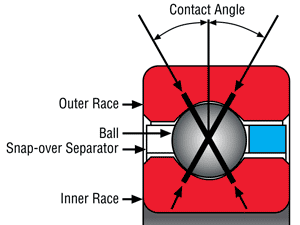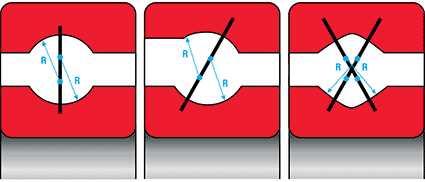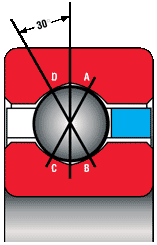
Kaydon type X – four-point contact thin section bearing is distinguished from Kaydon types A and C by the geometry of its ball grooves.

Type C: Radial contact (left)
Type A: Angular contact (center)
Type X: Four-point contact (right)
In Kaydon type C thin section bearings, the centers of the radii both lie in the plane of the ball centers. In Kaydon type A thin section bearings, the races and balls are in angular contact, and the centers of the groove radii are offset equal amounts on either side of the plane of the ball centers. In Kaydon type X bearing the groove in each race has two radii whose centers are offset from the plane of the ball centers. The latter construction gives the type X bearing its unique 'Gothic arch' configuration, making possible four contact points between a ball and the raceways.
Kaydon type X thin section bearings are assembled by either the Conrad or filling slot method. In a Conrad assembly, the bearing is assembled by eccentric displacement of the inner race within the outer race which permits insertion of about half of a full complement of balls. After insertion of the balls, the races are positioned concentrically and the balls are spaced about the entire circumference for assembly of the separator.
The 'filling slot' method inserts balls through a filling slot made by notching the raceway shoulder of one or both races. This method permits assembly with up to a full complement of balls for additional load capacity. With a filling slot, both the dynamic radial and thrust capabilities are impaired by the interruption of the ball contact path, and speed of rotation must be limited.
The depth of groove in the type X bearing is the same as in types A and C (25% of ball diameter). The deep groove combined with the four-point contact geometry enables this bearing to resist a combination of radial, thrust, and moment loading. The manner in which the bearing accomplishes this is similar to that of a pair of type A bearings duplexed back-to-back.
An axial force applied to the inner race from right to left is passed from the race to the ball at point B in the drawing below. It is then transmitted through the ball to point D where it passes into the outer race and support structure. The line of action BD forms a nominal 30° angle with the radial centerline of the bearing. Because of the elastic deformation of the ball and the race grooves along the load-transmission line, the ball load is relieved at points A and C, permitting smooth rotation around an axis perpendicular to line BD. With an axial force applied to the inner race from left to right, a similar transmission of load occurs between points C and A.

Moment or overturning load
By its ability to resist radial, thrust, and moment loads in any combination, the type X bearing is often able to replace two bearings—a pair of angular contact ball bearings, a pair of tapered roller bearings, or a combination of thrust and radial bearings, either ball or roller.
As in the case of the type C bearing, type X bearings are normally supplied with diametral clearance. The latter bearing, however, is not dependent upon this clearance for its nominal contact angle and thrust capacity. On the contrary, where thrust or moment loading is considerable, the clearance should be minimized to prevent the angle of contact from becoming excessive. For many applications requiring greater stiffness, Reali-Slim type X bearings are furnished with an internal preload. This is accomplished by using balls larger in diameter than the space provided between the raceways. The balls and raceways in this case have some elastic deformation without the presence of external load.
A moment or overturning load is similar to two thrust loads acting in opposite directions at diametrically opposite sides of the bearing. With a moment load, the loading on one side of the bearing will pass from point B to D, relieving points A and C. Directly across the bearing, the load passes from point C to point A, relieving points B and D.
A radial load is resisted equally across the lines of contact CA and BD. Under combined loading the resistance is a long both lines of contact with the magnitude of each reaction dependent upon the relationship of the individual loads.
NOTE: Type X bearings are designed to be used singularly. Use of two type X bearings on a common shaft could result in objectionable friction torque.
